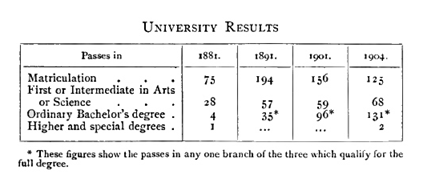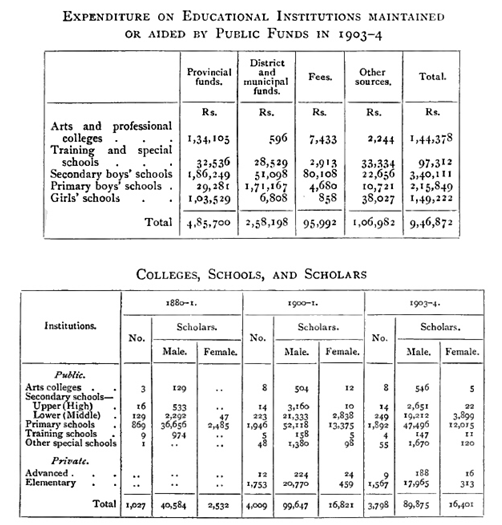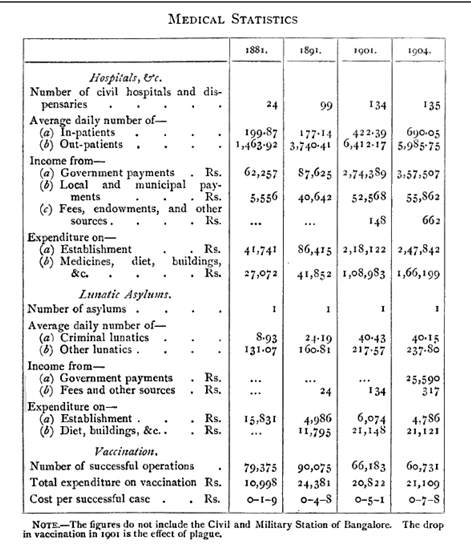Mysore State: Education, 1909
This is a collection of articles archived for the excellence of their content. Readers will be able to edit existing articles and post new articles directly |
Contents |
Bacteriological Institute
In 1896 an Eye Infirmary was established, and in 1899 a well-equipped Bacteriological Institute. Quinine was sold in 1904 in 3,426 packets, containing 102 powders of five grains each, at 418 post offices. The dose was raised in 1905 to seven grains, and it is proposed to sell through the village officials as well.
Education
Education on modern lines was first introduced by European missionaries. In 1826 a Mysore Mission College was proposed for Bangalore by the London Mission, conducted by a staff of European professors, aided by learned pandits, and designed to attract students from all parts of India. But their home authorities were not prepared to carry it out.
Between 1840 and 1854 the Wesleyans established schools at some of the District head-quarters with aid from Government, the principal being their institution at Bangalore, founded in 1851. At Mysore the Mahārājā maintained an English free school. The State expenditure on education in 1855 was Rs. 16,500 a year.
The Educational department was formed in 1857, and in 1858 a high school affiliated to the Madras University was established at Bangalore, converted in 1875 into the Central College. The Wesleyan schools in the Districts were taken over by Government, and vernacular schools gradually established in the tāluks. In 1861 a normal school, and in 1862 an engineering school, were attached to the high school at Bangalore.
In 1868 the hobli school system, for extending primary education among the masses, was introduced, and greatly added to the operations of the department. The schools were to be supported by a local cess ; but in 1872 the proportion of 24 per cent. of Local funds was allotted as the village school fund, raised in 1903 to 33 per cent.
The famine of 1876-8 had a disastrous effect on all public undertakings. Education, which had greatly flourished, both public and private, was starved for want of funds. The normal schools were closed, the European Inspectors were dispensed with, the Director of Public Instruction was placed in charge of the Census and the Police in addition to Education, and later on of Archaeology instead of Police, all the cost of vernacular schools was thrown on Local funds, and rigid economy stood in the way of any expansion.
In 1884 a revision was made of the higher institutions, but it was not till 1890 that a freer expenditure enabled progressive measures to be adopted. In 1887 the Mysore local examinations were instituted for teachers and pupils of vernacular schools, giving a definite aim to the courses of study. At the end of 1888 education in the Civil and Military Station of Bangalore was transferred to the Madras Educational department. In 1889 the cost of the tāluk vernacular schools was again made a charge on State [S. 243] funds, thus relieving the village school fund. In 1891 the number of native Deputy-Inspectors was doubled.
The department is now controlled by an Inspector-General of Education, whose head-quarters were removed to Mysore in 1894 but again established at Bangalore in 1899. The State was divided in 1903 into two portions for control and inspection, between the Inspector-General and his Assistant. The former retains the eastern Districts, with head-quarters at Bangalore, and the latter has charge of the western Districts, with head-quarters at Mysore city. The only Europeans recruited from England are the heads of the colleges at Bangalore and Mysore. The inspecting staff was further strengthened in 1905.
Of the colleges affiliated to the Madras University, those of the first grade are the Central College at Bangalore and the Mahārāja's College at Mysore city. The former takes mathematics and physical science as the optional subjects for the B.A. degree, and the latter mathematics and history.
The second-grade colleges are the St. Joseph's College at Bangalore, the Mahārānī's College at Mysore city, and the Sacred Heart College attached to the Convent of the Good Shepherd at Bangalore. This last and St. Joseph's are aided from the revenues of the Assigned Tract, and the others are supported by the State. The first-grade colleges are provided with hostels.
There are also Sanskrit colleges of a high standard at Mysore, Bangalore, and Melukote, the two latter being aided. Bangalore has, moreover, been selected as the site of the Indian Institute of Research for post-graduate study, to be founded on Mr. Tata's endowment.
Secondary schools include high schools and middle schools. The former have the matriculation examination as their goal, while the latter prepare for the lower secondary examinations, the course being partly English and partly vernacular. In 1904 there were 202 State, 3 municipal, 55 aided, and 3 unaided schools, the last being middle schools. The amount of aid to private schools is based on their expenditure, and their efficiency as tested by the reports of Inspectors and results of public examinations. The proportion of the male population of school-going age under secondary instruction in 1904 was 2 per cent. [S. 244]
The primary stages are divided into upper and lower, the latter ending with the ability to read from printed books. In 1904 there were 1593 State, 285 aided, and 14 unaided primary schools. As to the qualifications of the teachers, out of 3,179 in State employ, 149 held a normal school or teacher's certificate, others had passed various examinations, including 154 who had passed the University matriculation or higher tests, leaving 1,002 who had not passed any.
The minimum pay of the village schoolmasters was raised from Rs. 5 to Rs. 7 a month in 1901, but better prospects are needed for their future. With a view to providing funds for this purpose, the levy of fees has been introduced in all village schools, except in the lower primary classes, and the former rates of fees in other schools have been raised all round. For the benefit of children of artisans and agriculturists above 15, night schools have been opened, of which there are 67, with 1,500 pupils, most of them in the east, but some in all Districts. There are local committees for the control of all hobli and village schools.
The first girls' schools were established by European missionary ladies at Bangalore in 1840. Mission girls' schools were opened later in some of the large towns. In 1868 the Government began with one in Bangalore, and as years went on the number increased all over the country.
The hobli schools established in 1868 received both boys and girls together. Owing to the early marriage system, which did not admit of girls staying beyond the age of ten, and the entire want of female teachers, the girls' schools were really infant schools. But the mission schools had an advantage in both respects, being able to keep their girls longer, and to provide native Christian women as teachers.
One of the steps that gave an impetus to public female education was the establishment at Mysore city of the Mahāram's Girls' School in 1881. This was confined to high-caste girls, and, with an unstinted expenditure, gave a free education. Its influential patronage overcame all objections, and it presented an acceptable compromise between Western methods and Eastern views as to the appropriate subjects of female education.
It has for some years had Lady Superintendents from Girton or Newnham, and in 1902 was formed into a college, affiliated to the Madras University. Two Brāhman students took the B.A. degree in 1906. Admission is also now allowed of Christians and girls of low castes, provided they are of respectable family and approved by the management.
By liberal scholarships girls have been induced to stay longer at school, and female teachers have been trained from among young widows, of whom there are at present ten adult and fourteen child-widows. The management is in the hands of a committee, and local committees have been appointed for girls' schools [S. 245] in other parts of the country. These are, however, reported to take little interest in the matter as a rule.
In 1881, 1891, and 1901 respectively there were 46, 113, and 230 girls' colleges and schools, the percentage of girls under instruction to the female population of school-going age being 0.81, 3.14, and 4.2 2. In 1904 there were 243 schools, and the proportion was 4 per cent. The State funds contributed 1¼ lakhs (of which Rs. 38,000 was for the Mahārānī's College), and Local and municipal funds Rs. 6,800, to female education in 1903-4.
The high school classes learn English as a first language. In the highest class of the middle school English is begun as a second language. Zanāna teaching is carried on by ladies of the Church of England Zanāna Mission in Bangalore, Mysore city, and Channapatna, chiefly among Musalmān families.
There are State normal schools at Mysore city, Kolār, and Shimoga, for training teachers ; also a training department in the Mahārānī's College. State industrial schools are at work in Mysore and Hassan, mission industrial schools at Tumkūr and Kolār, with one for girls at Hassan, and a private industrial school at Melukote.
Fees in State colleges and schools
The scale of fees in State colleges and schools was raised in 1904 to the following monthly rates : Village schools, lower primary, free ; upper, 1 anna ; middle, 2 annas. Tāluk schools, lower primary, 2 annas ; upper, 3 annas ; middle, 4 annas. English middle schools, 8 annas, 12 annas, R. 1, Rs. 1-4, and Rs. 1-8, according to class. English high schools, Rs. 2 and Rs. 2-8 ; F.A. class, Rs. 4 ; B.A. class, Rs. 5.
Industrial School
The industrial school at Mysore has recently been reorganized1 and placed under an experienced Superintendent, who also inspects the other industrial schools in the State. An engineering school has been established at Mysore, for training subordinates for the Public Works department. Weaving schools have been opened at Hole-Narsipur, Dod-Ballāpur, Chiknāyakanhalli, and Molakālmura, with carpentry and drawing classes attached. There are altogether eighteen industrial schools, of which six are weaving schools.
A school has been established at Channapatna for the revival of the decaying local industries of lacquer-work, and the preparation of steel wire for the strings of musical instruments. Commercial classes are conducted at Bangalore by certain officials, and receive aid from Government. Students are attached to the laboratories of the Agricultural Chemist, the State Geologist, and the State Bacteriologist, and also to the silk farm established by Mr. Tata, and to the workshops of the Southern Mahratta Railway.
Those at the silk farm are village schoolmasters, of whom five are trained annually, and then appointed as inspectors of sericulture. State scholarships are given to students from Mysore learning electricity at New York, forestry at Oxford, and in the Teachers', Engineering, Medical, and Veterinary colleges of Madras or Bombay, in the Victoria Jubilee Institute and schools of Art at those places, and in the Forest School at Dehra Dun. One-fifth of the income from the Dāmodar Dās Charity Fund, yielding about Rs. 20,000 a year, has been assigned for scholarships to Gujarātī students selected by a committee—nine to those studying for the [S. 246] Bombay University examinations, one for a student of engineering or agriculture, and one for medicine. The remaining four-fifths are intended for post-graduate scholarships.
One has been granted to a student for the history and economics tripos at Cambridge, and one to a student for the M.B. and C.M. course at Edinburgh, with a special view to practical microscope work. An institution of a special nature deserving of notice is the school for deaf-mutes and the blind at Mysore city, managed by a committee.
1 The Prince of Wales, on his recent visit to Mysore, laid the foundation stone of new buildings for it, to be called the Chāmarājendra Industrial Institute.
Most of the institutions for Europeans and Eurasians are in the Civil and Military Station of Bangalore, but the returns do not include regimental schools under the Army department. The number of pupils in the public schools was 1,314 in 1904.
In the rest of the State there were 361, the majority being at the Urigam school on the Kolār Gold Fields. St. Joseph's College did well in the First Arts and matriculation. One European girl has passed the B.A. degree examination in English and French, and two the F.A. from the Sacred Heart and the Central College. The popular callings for young men are in the railway and telegraph departments, and the engineering and medical professions. Girls become nurses and governesses.
The number of Muhammadan pupils in all schools was 4,330 in 1881, 10,185 in 1891, 14,612 in 1901, and 13,383 (10,454 boys and 2,929 girls) in 1904. Six passed certain branches of the B.A. examination, one the First Arts, and one the matriculation. Only half-fees are levied from Muhammadan boys in all schools, and girls are free.
There are also twenty-six scholarships allotted for Muhammadan students in the Central College, to encourage English education among them. Owing to the dearth of qualified teachers, the village Hindustānī schools are in a very poor condition. In 1904 there were 15 Muhammadans attending colleges, 3,581 in secondary schools, and 8,848 in primary schools. Some have received scholarships at the M.A.O. college at Aligarh.
An interesting effort has been made to introduce education among the Lambānis. In all, 12 schools have been opened for them—7 in Shimoga District, and the others in Tumkūr, Chitaldroog, and Hassan Districts. They were attended in 1904 by 235 boys and 10 girls. For the low castes or Panchamās there are 70 schools, with 1,910 pupils, of whom 277 are girls.
The proportion of the population of school-going age under instruction was 11 in 1881, 9 in 1891, 14 in 1901, and 13 in 1904. At the Census of 1901 the proportion of the population able to read and write was 5.06 per cent., being 9.27 per cent. for males, and 0.77 for females. The cities and the Gold Fields have the highest percentage ; and of the Districts, Kadūr stands highest and Mysore lowest. Shimoga, next to Kadūr, has the highest percentage of literate males, [S. 247] and Tumkūr of literate females.
Medical School
A Medical School was established in 1882 for training subordinates, but was given up in 1886 in favour of paying students to attend the large and well-equipped Medical Colleges at Madras and Bombay. A local medical service was organized in 1884 and improved in 1897.
For women and children there are the Mahārānī's Hospital at Mysore, the Maternity at Bangalore, the Lady Curzon in connexion [S. 249] with the Bowring, and the Gosha Hospital of the Zanāna Mission. Native midwives are supplied to all the tāluks, who have been trained in the Lying-in Hospital at Madras, or in classes at the hospitals in Bangalore and Mysore city.
There is a Lunatic Asylum at Bangalore, in which at the end of 1903 there were 228 male and 86 female patients. During the year 24 were discharged as cured, and 11 as improved, while 23 died. The lunatics are employed in weaving cloth and kamblis, spinning, and gardening. In the Leper Asylum there were 11 male and 6 female lepers.
For vaccination there are 96 tāluk and 9 municipal vaccinators, besides the medical subordinates, and supervision is exercised by [S. 250] 9 inspectors. Vaccination is compulsory among State servants and school children1. Owing to the difficulties in the way of procuring good infant lymph for vaccination, a Vaccine Institute was established at Bangalore in 1892 for preparing lymph from the calf, in lanoline.
1 A Regulation passed in 1906 makes vaccination compulsory throughout 'notified areas.'


